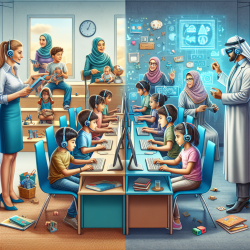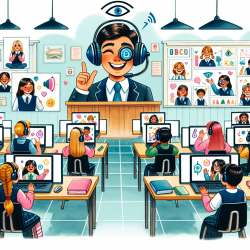Welcome to a world where the digital transformation in education is not just reshaping how we teach but also how we provide essential services to our children. As speech therapists, we are at the forefront of this change, pioneering a future where virtual therapy becomes a mainstay in schools. Today, let's indulge our curiosity and explore how online therapy services, like those provided by TinyEYE, are revolutionizing speech therapy staffing and the support we offer to our students.
Imagine a scenario where every child, regardless of their geographical location or the staffing constraints of their school, has access to high-quality speech therapy. This is not a distant dream but a tangible reality made possible through virtual therapy. As speech-language pathologists (SLPs), we are no strangers to the challenges faced in school settings – from high caseloads to limited resources. However, the advent of teletherapy is writing a new chapter in the annals of educational support services.
Virtual therapy is more than just a technological advancement; it is a beacon of hope for countless children who might otherwise go without the speech therapy they need. Online platforms, such as those offered by TinyEYE, have developed comprehensive and interactive therapy tools that can be tailored to each child's unique needs. But what does this mean for you, the speech therapist, and the schools we serve?
Firstly, let's talk about speech therapy staffing. One of the most significant advantages of virtual therapy is the ability to bridge the gap between the demand for SLPs and the availability of skilled professionals. By harnessing the power of the internet, schools can now connect with qualified therapists beyond their local area, ensuring that no child is left behind due to a lack of in-person specialists. This not only expands the reach of our services but also offers SLPs the flexibility to work remotely, creating a work-life balance that was previously unattainable.
Furthermore, virtual therapy opens up a world of opportunities for continuous learning and professional development. As therapists, we are lifelong learners, always seeking new ways to enhance our skills and stay abreast of the latest methodologies. Online therapy platforms provide an array of resources, from webinars to peer collaborations, ensuring that we remain at the cutting edge of our field. This ongoing education directly benefits the children we serve, as we bring the most current and effective practices to our virtual therapy sessions.
Now, let's consider the impact on the children – the heart of our profession. Virtual therapy is not a one-size-fits-all solution; it is a versatile tool that can be adapted to each child's individual learning style and pace. Interactive games, video modeling, and real-time feedback are just a few examples of how online therapy can engage students in ways that traditional methods may not. By providing a stimulating and supportive environment, virtual therapy can lead to significant improvements in speech and language outcomes for children.
Moreover, the use of virtual therapy in schools can foster a more inclusive atmosphere. Children with mobility challenges or those who are immunocompromised can receive consistent therapy without the physical barriers that may have hindered their progress in the past. It also allows for greater parental involvement, as sessions can be conducted from the comfort of home, enabling parents to observe and participate in their child's development.
Of course, any discussion about virtual therapy must address the concerns of efficacy and personal connection. Some may wonder if online therapy can truly replace the face-to-face interaction that is so vital to our work. The answer lies in the successful outcomes and positive feedback from schools, parents, and students alike. By utilizing high-quality video conferencing and interactive tools, we can maintain the personal touch that is essential to building rapport and trust with our students. The results speak for themselves – children continue to make strides in their speech and language skills, often with renewed enthusiasm for the therapy process.
In the business of education and therapy, we are executive decision-makers, always looking for the most efficient and effective solutions. Virtual therapy is a strategic choice that aligns with this ethos. It offers cost savings for schools, reduces travel time for therapists, and provides a scalable solution to meet the growing needs of our student populations. As business-minded professionals, we can appreciate the value that online therapy services bring to the table – both in terms of outcomes and operational efficiency.
As we look to the future, the role of virtual therapy in schools is set to expand even further. The global events of recent years have accelerated the adoption of teletherapy, and it is clear that it will continue to be a vital component of speech therapy staffing solutions. We are at the helm of a shift in how educational services are delivered, and the potential for innovation is boundless.
So, let us be inspired by the possibilities that virtual therapy presents. Let us embrace the opportunity to reach more children, to provide equitable access to speech therapy, and to enhance our own professional journeys. The future is bright, and together, we can ensure that every child has the support they need to find their voice and achieve their full potential.
In conclusion, virtual therapy is not just a fleeting trend; it is a robust and sustainable model for delivering speech therapy in schools. It is a testament to our adaptability as speech therapists and our unwavering commitment to the children we serve. With companies like TinyEYE leading the charge, the integration of online therapy services into school systems is transforming the landscape of speech therapy staffing and setting a new standard for excellence in educational support.
Let's continue to be curious, to explore, and to innovate. The journey of virtual therapy is just beginning, and we, as speech therapists, are the pioneers shaping its path. Together, we will continue to make a profound difference in the lives of children, one voice at a time.










